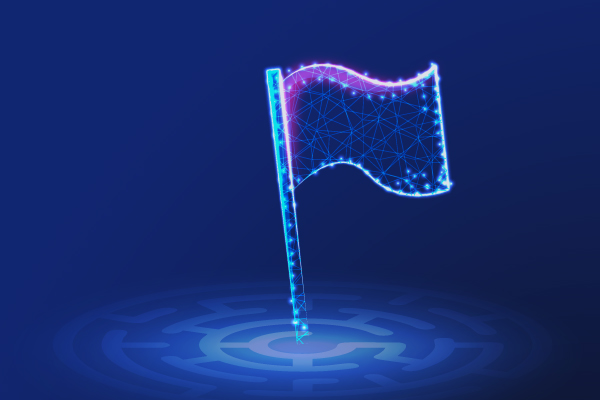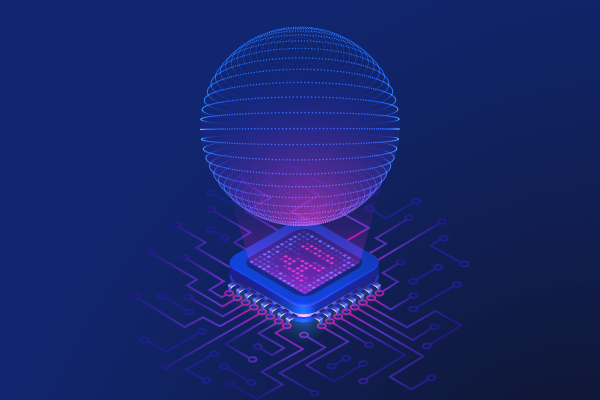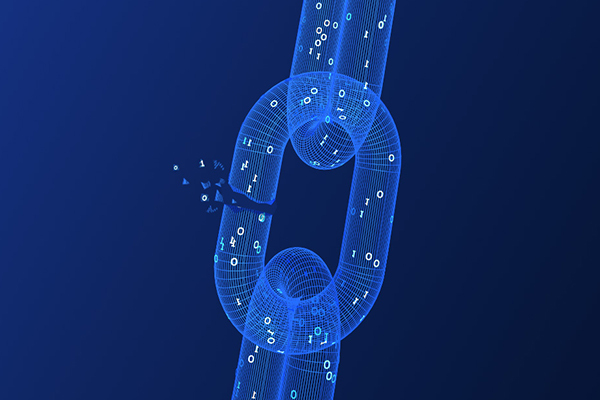Share Via
As organizations accelerate their adoption of cloud and as-a-service models to fuel innovation and sharpen their competitive edge, the importance of campus wired and wireless networks has become mission-critical. With constant connectivity and high-performance demands, network uptime and end-user performance we’ve shifted from technical requirements to strategic imperatives.
Ensuring an uninterrupted, high-quality network performance is essential for achieving operational goals and enhancing user experiences. This positions organizations to excel in today. Consequently, a performance guarantee can play a crucial role in mitigating the risk of service disruptions. This ensures your technology provider takes responsibility for your investment and business objectives.
At Nile, we’ve taken an AI networking and cloud-centric approach that leverages large-scale data collection, continuous monitoring, and closed-loop-automation. This enables us to leverage AI and machine learning throughout the network design and lifecycle management stages of a network. An end-to-end automation approach enables us to deliver the industry’s first financially-backed performance guarantee.
In fact, our modern approach to network software, hardware, and standardized design principles has enabled us to offer a 99.95% performance guarantee per building. The Nile Performance Guarantee is tied to the following three (3) critical Nile Access Service metrics:
- Availability: Guarantees traffic traverses through the Nile Service Block (NSB) unencumbered, across all wired and wireless network elements.
- Coverage: Ensures end users and IoT devices receive video-grade quality wireless coverage while connected to the Nile network within a building.
- Capacity: Continuously delivers assurances that the deployment is designed to handle the total number of connected user and IoT devices, application throughput, as well as latency requirements across the network.
What is AI’s role?
AI is essential to preserving the integrity of the Nile Service Block throughout its existence. It provides precise insights and automated resolution of wired and wireless network incidents throughout the entire production environment. This is achieved through:
- Standardized Design: AI tools for site discovery, wireless site survey, and digital twins are used at Day -1 to ensure that a network design meets standardized requirements so that a wired and wireless environment behaves in a uniform way across different deployments – offices, public venues, warehouses, etc.
- Automated Incident Resolution: From Day 1, our cloud AI platform continuously monitors Nile Service Block for anomalies to automatically take action in resolving incidents versus merely pointing out actions that IT must manually investigate and resolve. This is possible because of our tightly-knit integration of Nile wired and wireless nodes, and cloud-centric automation capabilities that traditional network architectures lack.
- Optimization: From an ongoing Day N perspective, our cloud-centric AI Networking and automation enables us to continuously optimize the network so that any chances of unforeseen incidents are eliminated, and the end-user experience remains uninterrupted. This is made possible through the use of sensors, and Smart Agents, their counterparts within Nile Cloud Services.
Ensuring Standardized Network Design
In conversations with customers, we have learned that ~80% of network problems are due to complex and siloed network designs. Therefore having a standardized and deterministic network design that covers the three areas described above is foundational to ensuring a performance guarantee. The following image illustrates our Day -1 to Day N design principles across Nile’s wired and wireless LAN.

The Design Pipeline module in the Nile Services Cloud orchestrates the site discovery and site survey process. During the site discovery process, a technician uses Nile’s AI-powered mobile application to gather information on the customer’s deployment environment. The collected information includes details such as:
- IDF/MDF racks, locations and cooling
- Switch port availability
- Existing cabling infrastructure
- RF environment and wireless site survey
- Users and applications
If any collected data within the Design Pipeline is missing or requires additional information, the mobile application technician is notified with context regarding what additional data is required.
Within the Design Pipeline, Nile’s Cognitive Decisions module monitors interference and signal attenuation of the RF environment and automatically determines the precise location and number of Nile access points to meet the service guarantees. The Cognitive Decisions module’s Natural Language Processing (NLP) AI capabilities automatically generate a digital twin of Nile Service Block (NSB), a bill of materials (BOM) necessary to deploy the topology based on the digital twin, and a connectivity and cabling plan for the installers to use when deploying the Nile Service Block.
We have also learned that a network undergoes performance fluctuations due to the number of users on site, the type of applications used, and various environmental aspects. Any deviations from the initial design cause the network to perform poorly. Hence, post-deployment, the Nile Access Service leverages Smart Agents to continuously collect data, and update and track changes to the digital twin in real-time.
Further insights into AI incident resolution capabilities
From the continuous collection of data across deployed networks, we have learned that network disruptions often go undetected, causing users to complain about poor connectivity or performance. For example, an intermittent cable or wireless AP experiencing interference can cause disruptions for days or weeks, and these issues are often difficult for a network engineer to identify and resolve.
The automation used to detect and resolve issues within the Nile AI implementation is designed to reduce Mean Time to Resolve (MTTR), thus helping us meet our performance guarantee baseline.
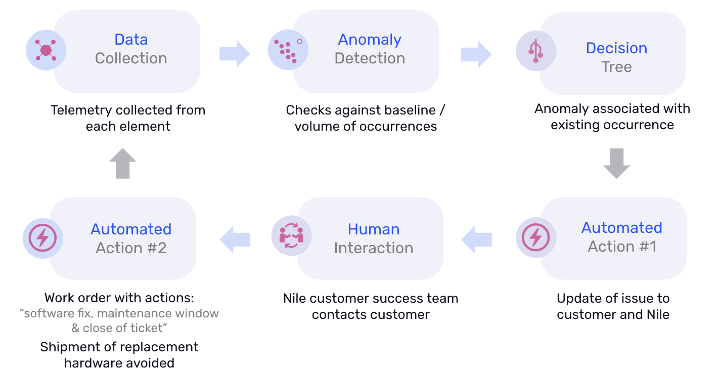
Our Smart Agents continuously collect the data and hydrate the digital twin, while our models within the Nile Services Cloud look for anomalies within this data. The AI models process real-time and historical data and predict the metric values needed to optimize the Nile network based on variable changes, such as adjusting a threshold for a future time period that takes into consideration influencing contextual factors. This removes the need to manually adjust thresholds or service level expectations that traditional network solutions often require. Factors that impact these automated changes include:
- Seasonality factors such as holidays, back to school, large events, etc.
- The rate at which variables change throughout the day or week
- Environmental conditions that affect wireless signals
- Changes in the mix of client devices and/or their behavior
A great example of where our dynamic threshold-based anomaly detection AI model can identify and automatically remediate an identified issue would be a sudden or gradual spike in CRC errors on one of the uplinks on a Nile wired distribution node. If left unidentified, that traffic will be blackholed until someone manually intervenes to fix the problem.
However, in a Nile deployment, our Cognitive Decisions module automatically identifies the CRC errors and proceeds to increase the cost associated with the routing protocol of the faulty links. The outcome is that the routing protocol updates steer the traffic around the anomalous link, maintaining the performance guarantee and ensuring an uninterrupted user experience.
While AI and automation handle these processes autonomously, the customer is also immediately alerted about the faulty cable, ensuring it can be repaired promptly and the network restored to optimal performance.
Continuous Network Optimization with AI
Continuous optimization of the network is made possible by the data collected by Nile sensors. Sensors are one of the key components of the Nile Services Block (NSB). During the deployment, physical sensors are deployed at strategic locations within a service area. The sensors provide an “outside-in” view of the network by closely emulating Wi-Fi-connected end-user devices.
An example of how our continuous network optimization works is with sensors and Wi-Fi channel planning. While channel planning algorithms have become increasingly advanced, they often lack insights from the perspective of the connected endpoint. Environmental RF changes may occur that are not detectable through AP-to-AP visibility alone. These changes often go unnoticed, resulting in poor Wi-Fi performance and end-user complaints.
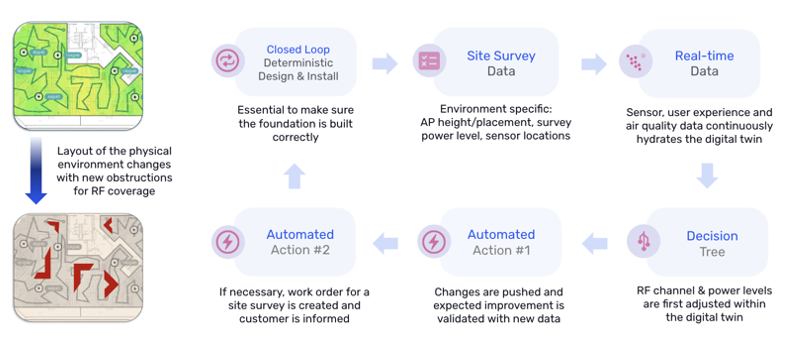
Nile sensors continuously collect data about overlapping wireless networks, Wi-Fi interference, and noise levels – all from the end users’ perspective. AI algorithms in the Cognitive Decisions module analyze the collected data and detect changes to the RF environment caused by transient or permanent interference. Nile’s Cognitive Decisions module then makes dynamic adjustments to channel and transmit power parameters. This ongoing optimization guarantees that the RF environment remains free of coverage gaps and maintains a smooth user experience without disruption.
Unprecedented reliability and performance with AI
Nile is proud to offer the industry’s first performance guarantee and a baseline of 99.95%, on a per-building basis across three very important areas: Availability, Capacity and Coverage. Nile can offer a performance guarantee in large part due to three key pillars:
- Deterministic Network Design: Every deployment follows deterministic principles, ensuring uniformity and reliability across environments.
- AI-Driven Incident Resolution: Autonomous detection and resolution of network incidents reduce downtime and eliminate manual intervention.
- Continuous Optimization: Any chances of unforeseen incidents is eliminated and the end user experience stays uninterrupted.
Feel free to reach out to discuss your environment, any AI questions, and how Nile can help deliver the best user experience possible.
For more on our AI networking features, the following provide valuable insights:

